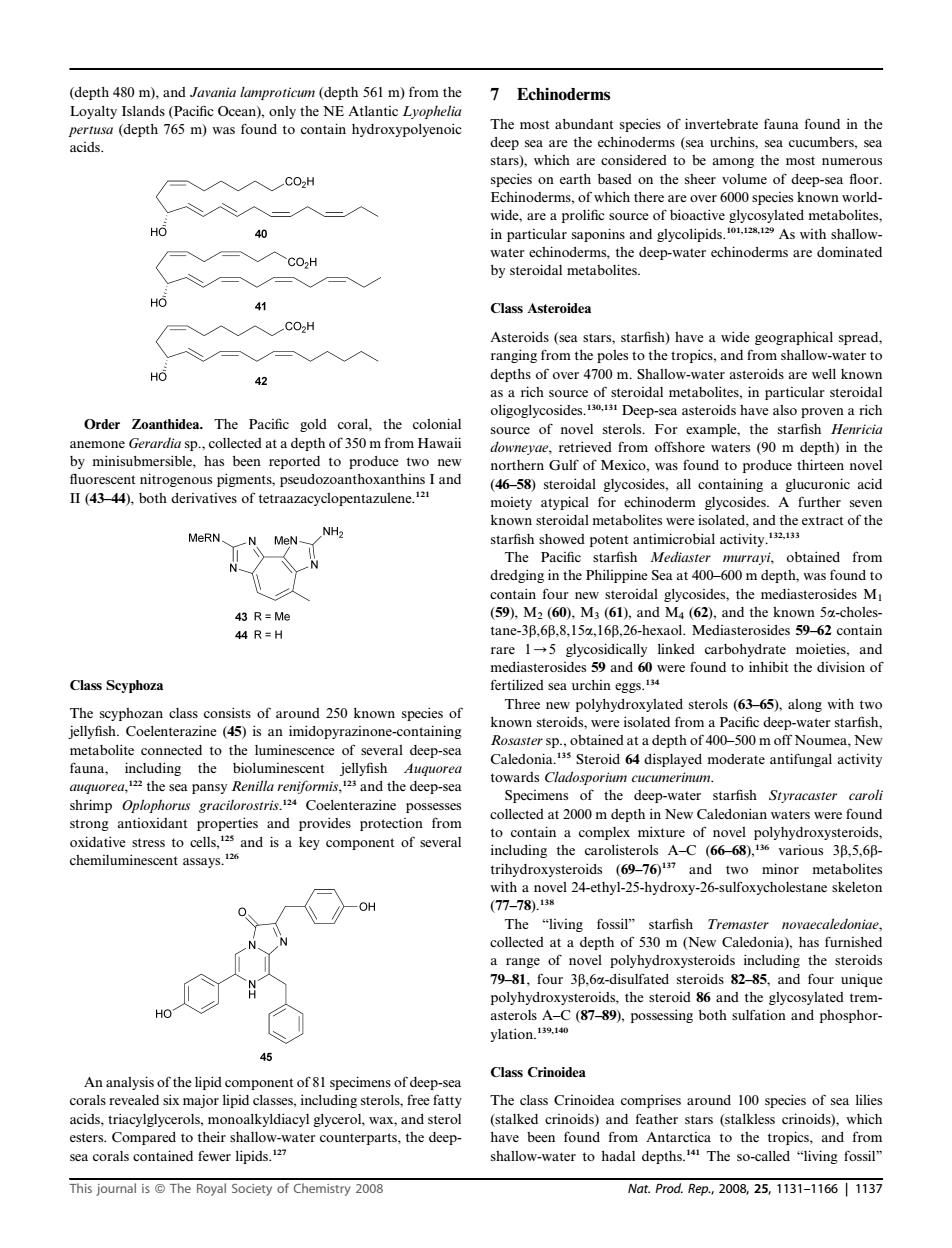正在加载图片...

(depth 48 m).and Javania lamproricum (depth 561 m)from the 7 Echinoderms The most abundant species of invertebrate fauna found in the CO.H ms, which the are over 6000 speci known world HO 40 COH deep-waterchnredomnaed by steroidal metabolites 41 ☑ass Asteroidea CO2H 4700 s to the tropics,and from 42 asa rich source of steroidal metabolites.in particular steroidal Order Zoanthidea.The Pacific gold coral.the colonial oligoglycosides. Deep-sea asteroids have also proven a rich anemone Gerardia sp.collected at a depth of350mfrom Hawaii by minisubmersible has been reported to produce northern Gulf of Mexico.was found to produce thirteen novel I).oetivoft MeRN、 The obtaine ontain four osidcs.the mediasterosides M 43 R=Me and the 44R=H found to inhibit the division of Class Scyphoza ertilized sea urchin eggs. Steroid 64 displayed moderate antifungal activity of the deep-water starfish Sryracaster caroli collected at 2000m depth in New Caledonian waters were found and is a key componen h trihydroxysteroids (69-76) and two minor metabolite (v24-cthyl-2-hydroxy- Caledonia)has fumished oxyste uding the steroids HO both suation and phosphor- ylation An analysis of the lipid com Class Crinoidea onent of 81 sp imens of dee corals revealed six major lipid classes including fatty The class Crinoidea comprises around 100 species of sea liie (stalke ods)and tea ther stars (stak ess cnnoids nd which This journal is e The Roval Society of Chemistry 2008 Nat.Prod..Rep,2008,25,1131-11661137(depth 480 m), and Javania lamproticum (depth 561 m) from the Loyalty Islands (Pacific Ocean), only the NE Atlantic Lyophelia pertusa (depth 765 m) was found to contain hydroxypolyenoic acids. Order Zoanthidea. The Pacific gold coral, the colonial anemone Gerardia sp., collected at a depth of 350 m from Hawaii by minisubmersible, has been reported to produce two new fluorescent nitrogenous pigments, pseudozoanthoxanthins I and II (43–44), both derivatives of tetraazacyclopentazulene.121 Class Scyphoza The scyphozan class consists of around 250 known species of jellyfish. Coelenterazine (45) is an imidopyrazinone-containing metabolite connected to the luminescence of several deep-sea fauna, including the bioluminescent jellyfish Auquorea auquorea, 122 the sea pansy Renilla reniformis, 123 and the deep-sea shrimp Oplophorus gracilorostris. 124 Coelenterazine possesses strong antioxidant properties and provides protection from oxidative stress to cells,125 and is a key component of several chemiluminescent assays.126 An analysis of the lipid component of 81 specimens of deep-sea corals revealed six major lipid classes, including sterols, free fatty acids, triacylglycerols, monoalkyldiacyl glycerol, wax, and sterol esters. Compared to their shallow-water counterparts, the deepsea corals contained fewer lipids.127 7 Echinoderms The most abundant species of invertebrate fauna found in the deep sea are the echinoderms (sea urchins, sea cucumbers, sea stars), which are considered to be among the most numerous species on earth based on the sheer volume of deep-sea floor. Echinoderms, of which there are over 6000 species known worldwide, are a prolific source of bioactive glycosylated metabolites, in particular saponins and glycolipids.101,128,129 As with shallowwater echinoderms, the deep-water echinoderms are dominated by steroidal metabolites. Class Asteroidea Asteroids (sea stars, starfish) have a wide geographical spread, ranging from the poles to the tropics, and from shallow-water to depths of over 4700 m. Shallow-water asteroids are well known as a rich source of steroidal metabolites, in particular steroidal oligoglycosides.130,131 Deep-sea asteroids have also proven a rich source of novel sterols. For example, the starfish Henricia downeyae, retrieved from offshore waters (90 m depth) in the northern Gulf of Mexico, was found to produce thirteen novel (46–58) steroidal glycosides, all containing a glucuronic acid moiety atypical for echinoderm glycosides. A further seven known steroidal metabolites were isolated, and the extract of the starfish showed potent antimicrobial activity.132,133 The Pacific starfish Mediaster murrayi, obtained from dredging in the Philippine Sea at 400–600 m depth, was found to contain four new steroidal glycosides, the mediasterosides M1 (59), M2 (60), M3 (61), and M4 (62), and the known 5a-cholestane-3b,6b,8,15a,16b,26-hexaol. Mediasterosides 59–62 contain rare 1/5 glycosidically linked carbohydrate moieties, and mediasterosides 59 and 60 were found to inhibit the division of fertilized sea urchin eggs.134 Three new polyhydroxylated sterols (63–65), along with two known steroids, were isolated from a Pacific deep-water starfish, Rosaster sp., obtained at a depth of 400–500 m off Noumea, New Caledonia.135 Steroid 64 displayed moderate antifungal activity towards Cladosporium cucumerinum. Specimens of the deep-water starfish Styracaster caroli collected at 2000 m depth in New Caledonian waters were found to contain a complex mixture of novel polyhydroxysteroids, including the carolisterols A–C (66–68),136 various 3b,5,6btrihydroxysteroids (69–76) 137 and two minor metabolites with a novel 24-ethyl-25-hydroxy-26-sulfoxycholestane skeleton (77–78).138 The ‘‘living fossil’’ starfish Tremaster novaecaledoniae, collected at a depth of 530 m (New Caledonia), has furnished a range of novel polyhydroxysteroids including the steroids 79–81, four 3b,6a-disulfated steroids 82–85, and four unique polyhydroxysteroids, the steroid 86 and the glycosylated tremasterols A–C (87–89), possessing both sulfation and phosphorylation.139,140 Class Crinoidea The class Crinoidea comprises around 100 species of sea lilies (stalked crinoids) and feather stars (stalkless crinoids), which have been found from Antarctica to the tropics, and from shallow-water to hadal depths.141 The so-called ‘‘living fossil’’ This journal is ª The Royal Society of Chemistry 2008 Nat. Prod. Rep., 2008, 25, 1131–1166 | 1137